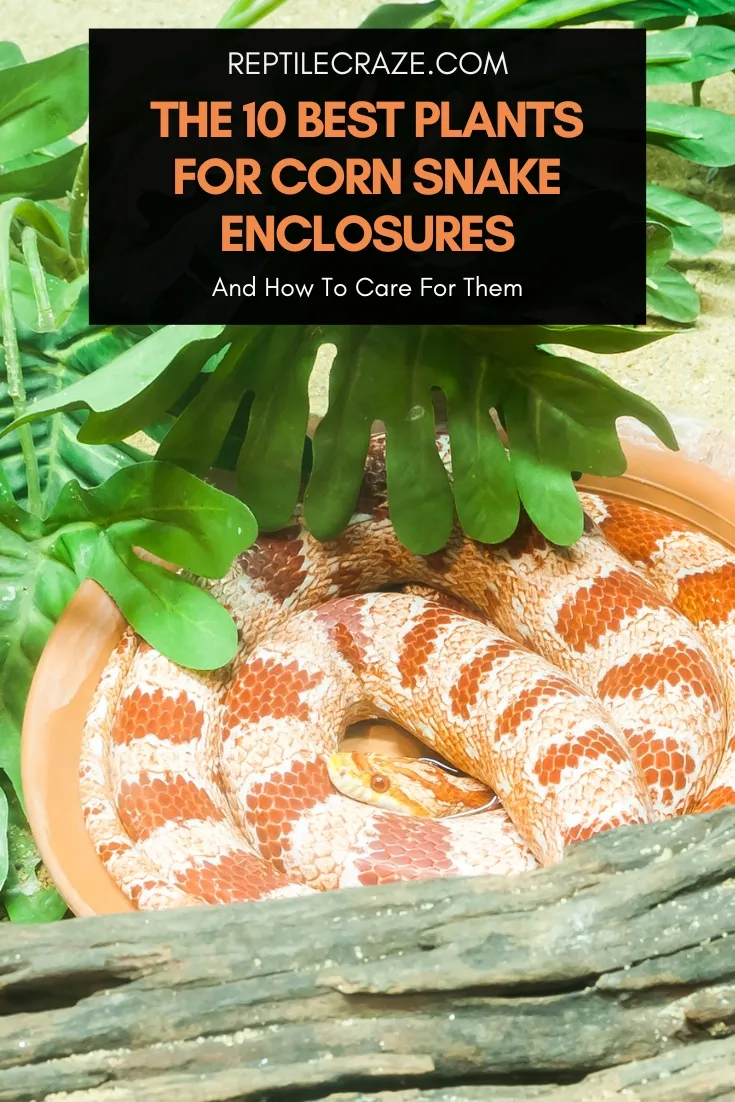
Decorating your corn snake’s habitat can truly be a challenge, especially if we’re discussing plants. While artificial plants work well in a reptile’s
Corn snakes are carnivorous reptiles, so they won’t eat the plants in their vivarium. However, some may still be toxic. You can choose among non-toxic species that will thrive in your snake’s environment – bromeliads, ferns, peperomias, orchids, and spider plants, to name a few.
Keep reading to learn more about these plants’ appearance and care requirements. The list of plants will then take you to some essential things to consider before buying a plant for your corn snake’s habitat.
Table of Contents
10 Best Plants For Corn Snake Habitats
While your corn snake will be happy with any plant that’s safe for it, you’ll definitely want to think twice before buying a plant for your reptile’s vivarium – after all, the caring falls on you.
If you’re a plant enthusiast, this won’t be a problem, and you probably won’t even mind caring for a high-maintenance plant.
On the other hand, if you don’t have extensive experience in growing plants and, above all, you don’t have the time for it, you might want to plant one that easily adapts to various conditions and doesn’t require much care.
Whatever plant you choose, we’d like to congratulate you on what you’re doing for your corn snake! A live plant won’t only mimic your pet’s natural habitat, thus making it feel more comfortable, but also freshen the air and help maintain adequate humidity levels.
Tip: If you’re unsure whether a plant is suitable for your snake’s habitat or whether it’s be toxic for your pet/s, you should ask your veterinarian for advice.
1. Bromeliads (Bromeliaceae)
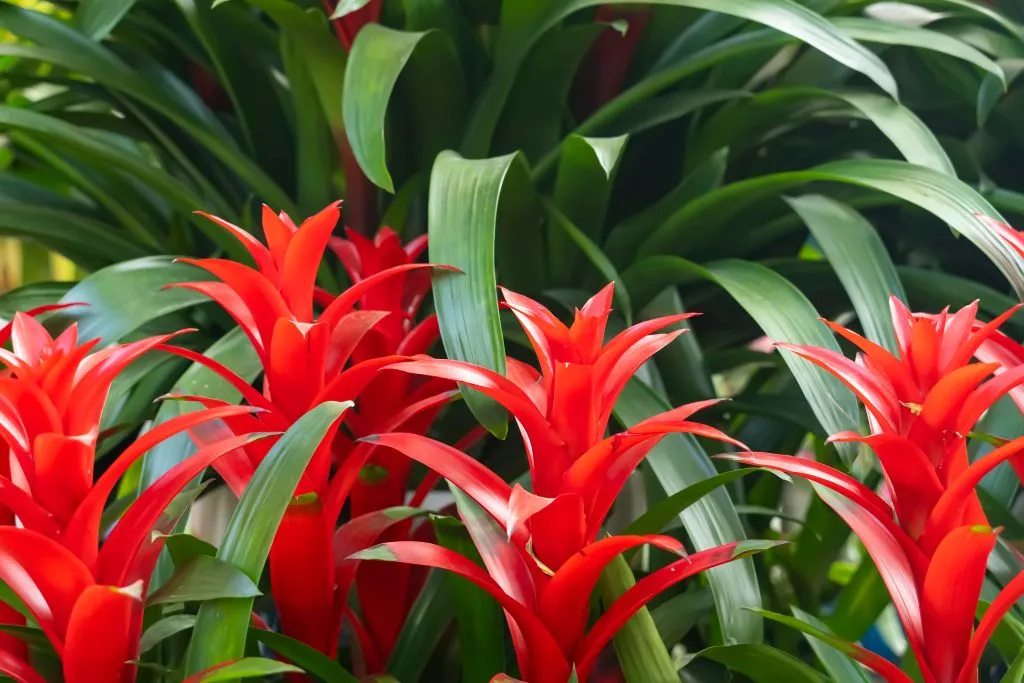
Bromeliads form the Bromeliaceae family of flowering plants. There are over 3,700 bromeliad species, so there are plenty to choose from! However, remember that not all may fit your
These plants can be terrestrial, epiphytic, or lithophytic. Epiphytic plants grow on other plants and absorb the moisture from the air and the debris around them. Lithophytic plants, on the other hand, grow in or on rocks. In short, you might not even need to plant it in the soil!
Bromeliads are known to adapt fast in various environments, which is why they can be a good choice for your snake’s
You might want to consider that they grow pretty slowly and can take 1-3 years to become mature flowering plants. If they do bloom, bromeliads produce beautiful flowers of various colors, depending on the species – green, purple, red, orange; a whole spectrum!
Tip: If you choose a bromeliad for your snake’s habitat, avoid the species with spines!
2. Peacock Plant (Goeppertia makoyana)
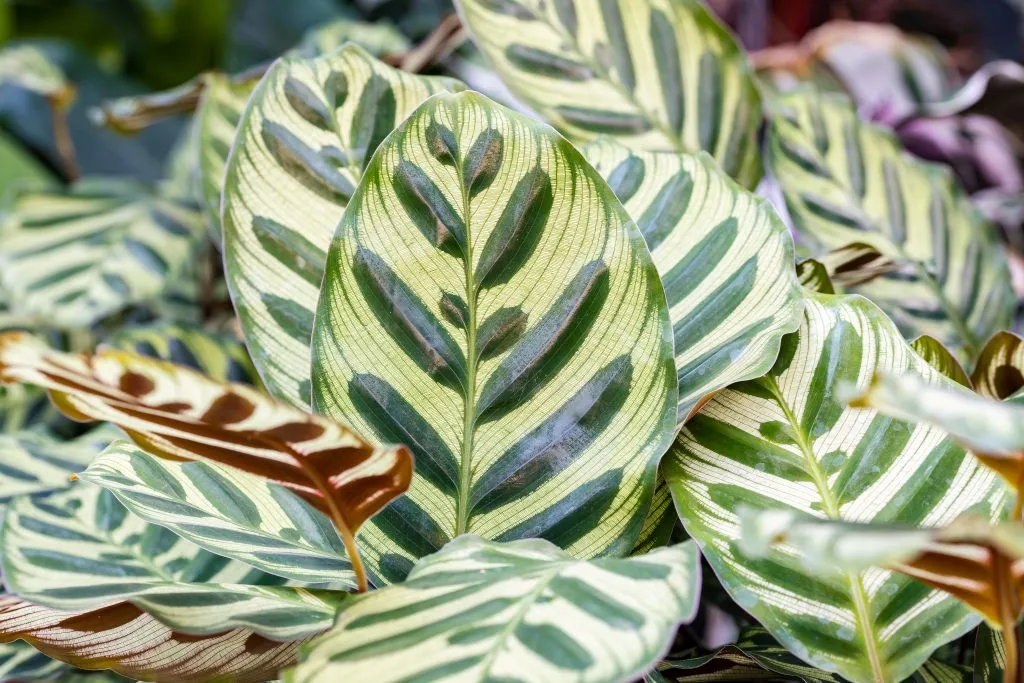
The peacock plant is scientifically known as Goeppertia makoyana. It’s a nice-looking evergreen perennial which develops round, glossy leaves with distinctive dark-green stripes on the upper surface.
The lower leaf surface, on the other hand, has a beautiful deep purple color. It can undoubtedly be a good addition to your snake’s vivarium!
On the other hand, this plant isn’t the easiest to take care of because it has pretty specific requirements.
For example, it should neither receive too much light nor full shade. Then, if it receives too much water, it can develop root rot and, as such, prefers even moisture levels.
However, if you’re already taking care of a reptile, we’re sure a plant won’t pose too many difficulties. So once you get its requirements right, you’ll enjoy seeing it in your corn snake’s vivarium!
3. Emerald Ripple Peperomia (Peperomia caperata)
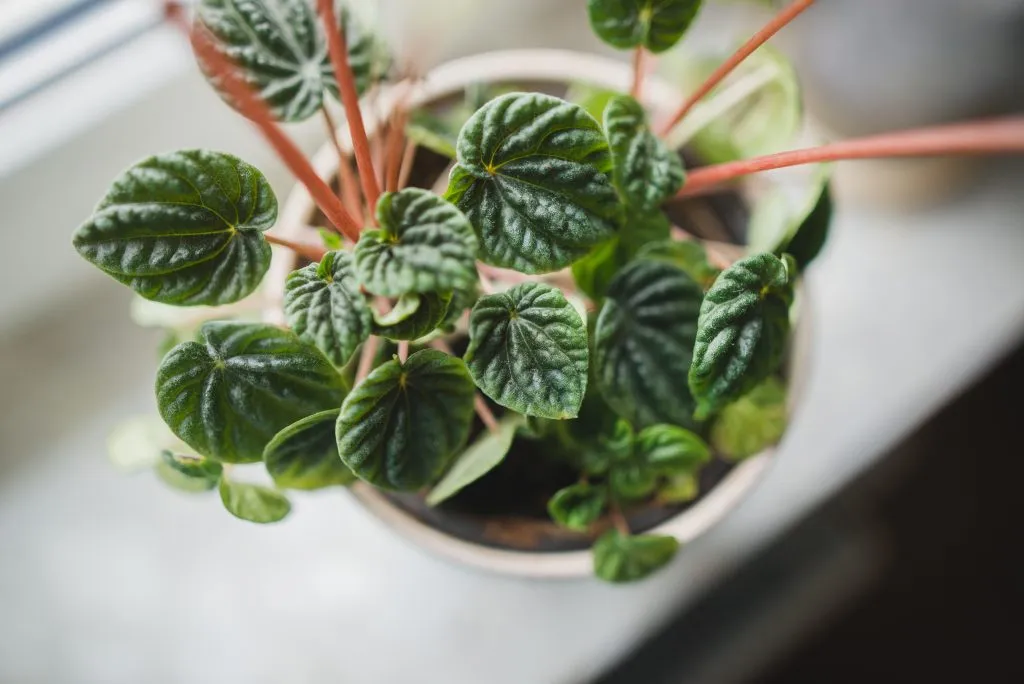
Yet another gorgeous plant that can do well in your snake’s habitat! The emerald ripple peperomia, otherwise known as Peperomia caperata, is an evergreen plant that produces heart-shaped leaves with a pleasant glossy, wrinkled appearance! How awesome is that?!
In the summer, the plant blooms, unraveling its beautiful white flower spikes, which makes it a popular houseplant among plant enthusiasts.
This is a slow-growing plant, which usually doesn’t reach more than 8 inches in height. It thrives in warm and humid places. You’ll need to water it at least once a week during the spring and summer, as these are the growing seasons.
On the other hand, emerald ripple peperomia requires approximately 40-50% humidity levels – slightly below what your snake needs. However, it is believed that these plants adapt well to various conditions, so why not give it a try?
4. Corn Plant (Dracaena fragrans)
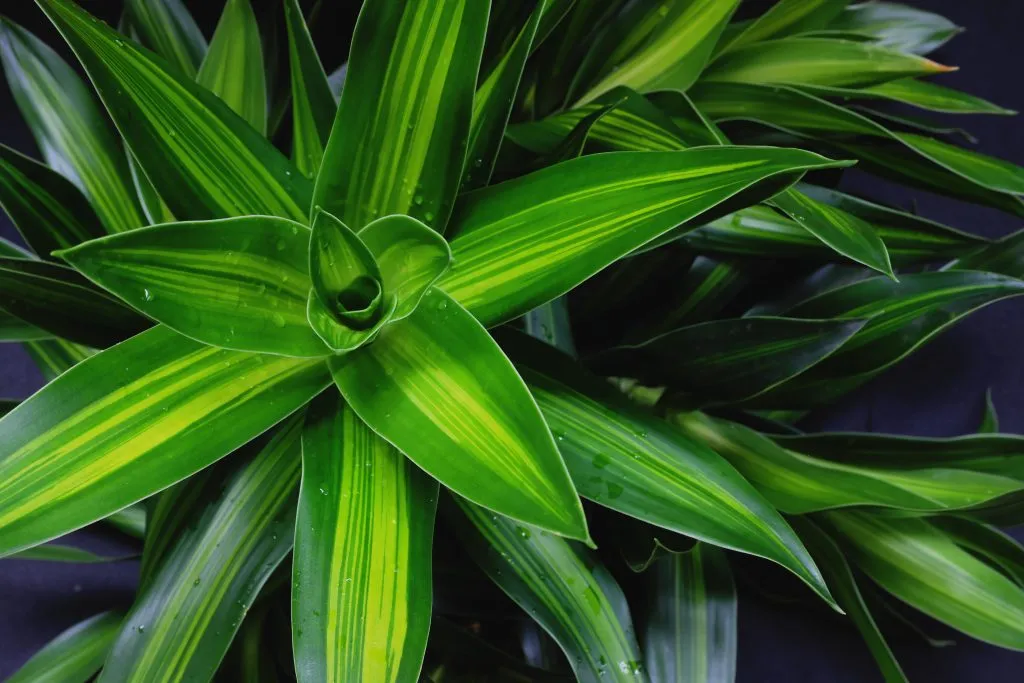
Corn plant, or as you might’ve heard of it, striped dracaena, is a flowering, slow-growing shrub with glossy, green leaves.
When in bloom, the corn plant reveals its unique white flowers with a distinctive red-purplish central line on each lobe. A corn plant will certainly give your snake’s
tank a unique touch!
Once you learn what this plant needs, you won’t have to put too much effort to sustain it.
On the other hand, this plant is toxic for cats and dogs, so if you have other pets, you should either go for another plant or ensure there’s no way they can get to it. (We know how curious cats and dogs can be – one look away and they’re near the
5. Golden Pothos (Epipremnum aureum)

The golden pothos plant could be exactly what you’ve been looking for! It’s a unique vine that can grow pretty large if there’s enough space. Above all, it’s extremely resilient, so you’ll have to try really hard to kill it! Besides, it is considered an excellent natural air purifier.
This plant has broad, heart-shaped leaves, featuring distinctive patterns of dark and bright green.
However, it might be toxic to other pets and even humans, so you might want to consider that. Luckily, corn snakes are carnivorous, so the plant won’t look too appetizing to them!
6. Ferns (Polypodiophyta)
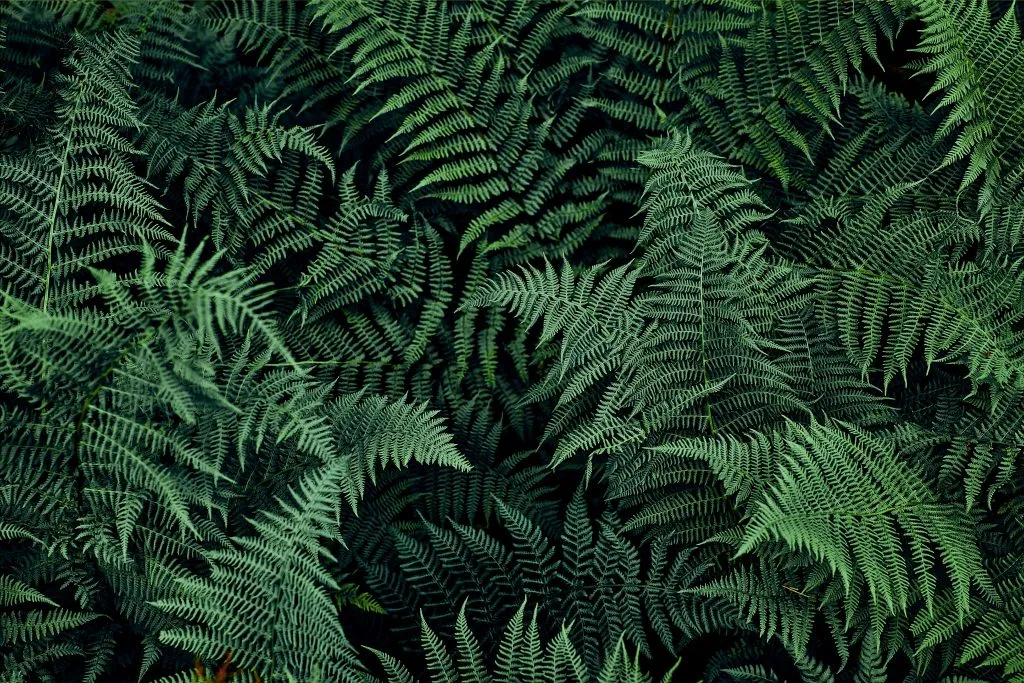
Ferns are very popular houseplants primarily because they’re pretty low-maintenance. Besides, they’re excellent at cleaning the air in your house!
Ferns are vascular plants that reproduce through spores and grow complex leaves. Fern leaves are actually called fronds.
The most challenging part about growing ferns is choosing one that’s not toxic for reptiles. While snakes are carnivorous and won’t eat the plant, they may still be affected by the scents the plant emits. As such, here are some fern species considered safe for reptiles:
- Common staghorn fern (Platycerium bifurcatum)
- Boston fern (Nephrolepis exaltata)
- Bird’s nest fern (Asplenium nidus)
- Northern maidenhair fern (Adiantum spp.)
7. Inch plant (Tradescantia zebrina)
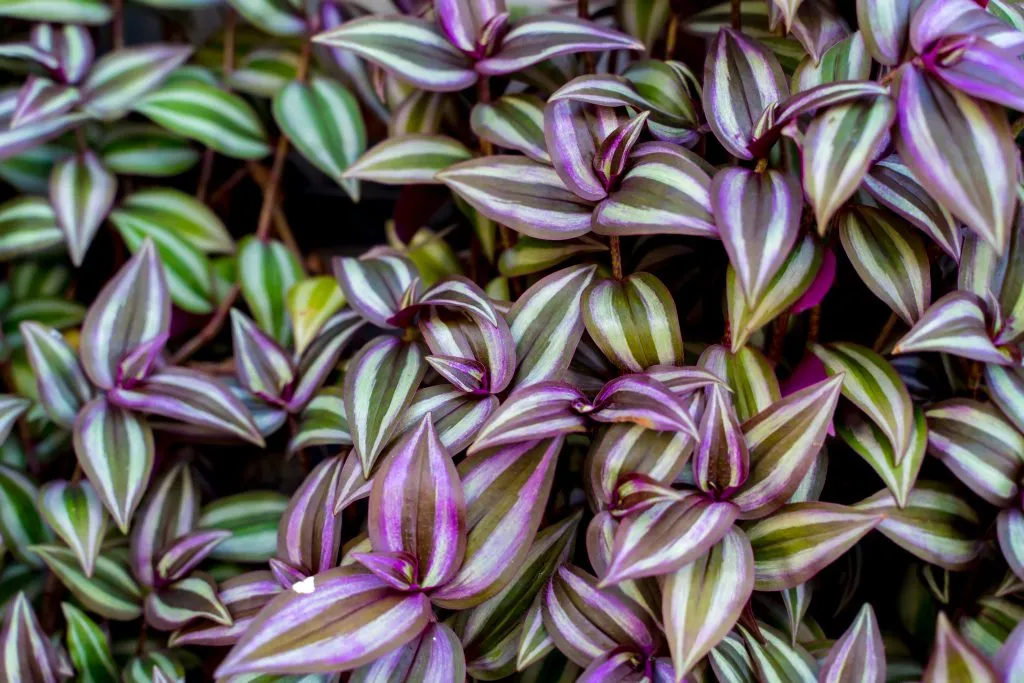
This is undoubtedly one of the most beautiful plants on our list, as its leaves have a zebra-like pattern – that is, the upper surface of the leaf has a longitudinal pattern alternating purple, green, and silver. That’s where its scientific name comes from – Tradescantia zebrina.
On the other hand, as tempting as this plant might be, it can cause skin irritation if touched. There’s little to no scientific evidence whether this might be a problem for your snake. On the contrary, some sources indicate it’s safe to be added to a
Therefore, while we consider that your snake won’t have any issues with an inch plant in its
8. Jewel Orchid (Ludisia discolor)
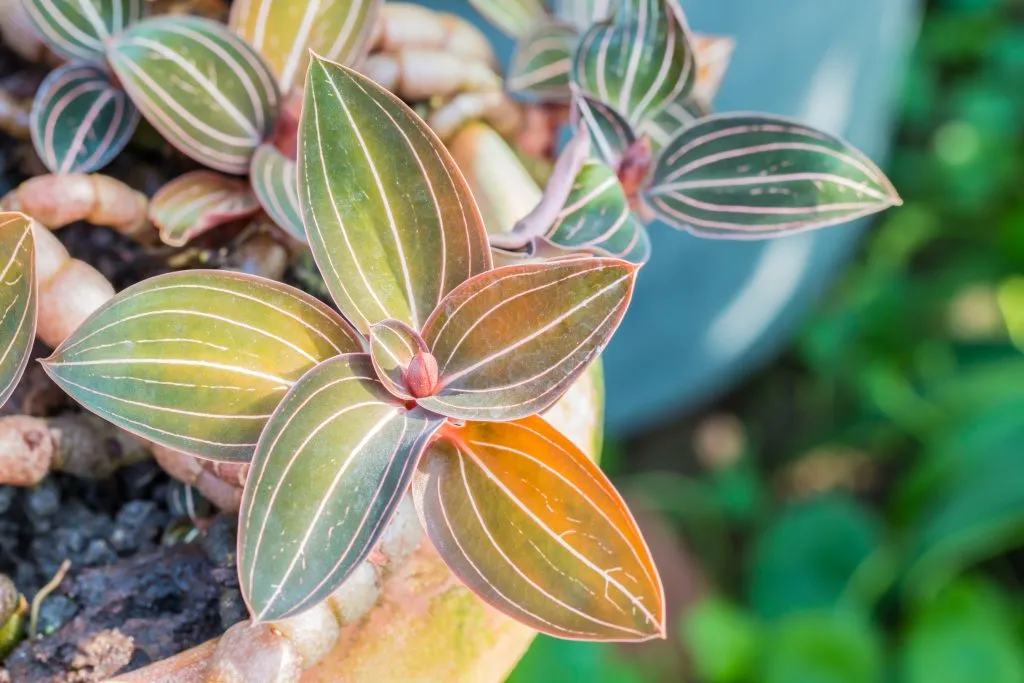
Jewel orchids are renowned for their unique foliage color and pattern – either velvety maroon, featuring reddish veins running along the leaves, or bright green, featuring white veins.
These orchids thrive in hot and humid conditions and enjoy low light. If they’re hidden somewhere underneath other leaves, the better.
If you manage to assure your jewel orchid optimal conditions, your corn snake will enjoy having its broad, beautiful leaves in its habitat!
There are two varieties you can choose from:
- Ludisia discolor ‘Alba’ – with bright green leaves
- Ludisia discolor ‘Nigrescens’ – with velvety maroon leaves
9. Heartleaf Philodendron (Philodendron hederaceum)
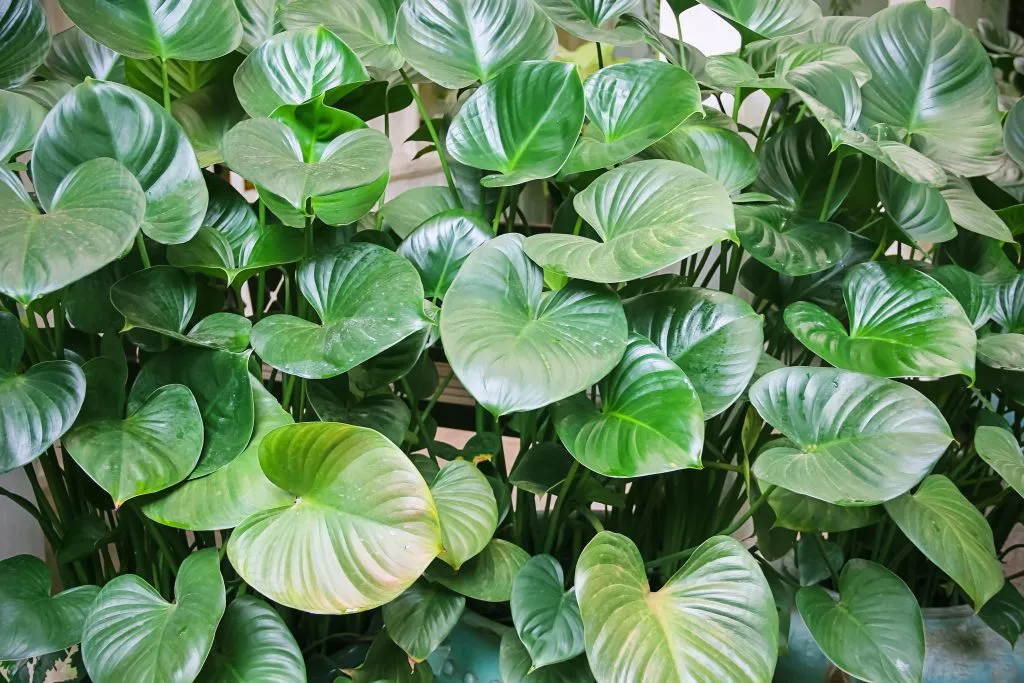
Otherwise known as Philodendron hederaceum, the heartleaf philodendron is an evergreen climber that produces (yet again!) heart-shaped leaves with a glossy appearance.
It’s favored as a houseplant because it’s easy to care for and remains green year-round! Moreover, it produces greenish-white flowers sometimes, so if you get some, you may consider yourself a great plant-keeper!
Besides, you can train the plant to grow the way you want inside your snake’s
On the other hand, because it contains calcium oxalate, it might be harmful to other pets and humans. So far, only mice and rats are officially known to be affected by this plant.
To avoid further surprises, don’t allow your other pets or kids anywhere near it if you take it out of your snake’s habitat.
10. Spider plant (Chlorophytum comosum)
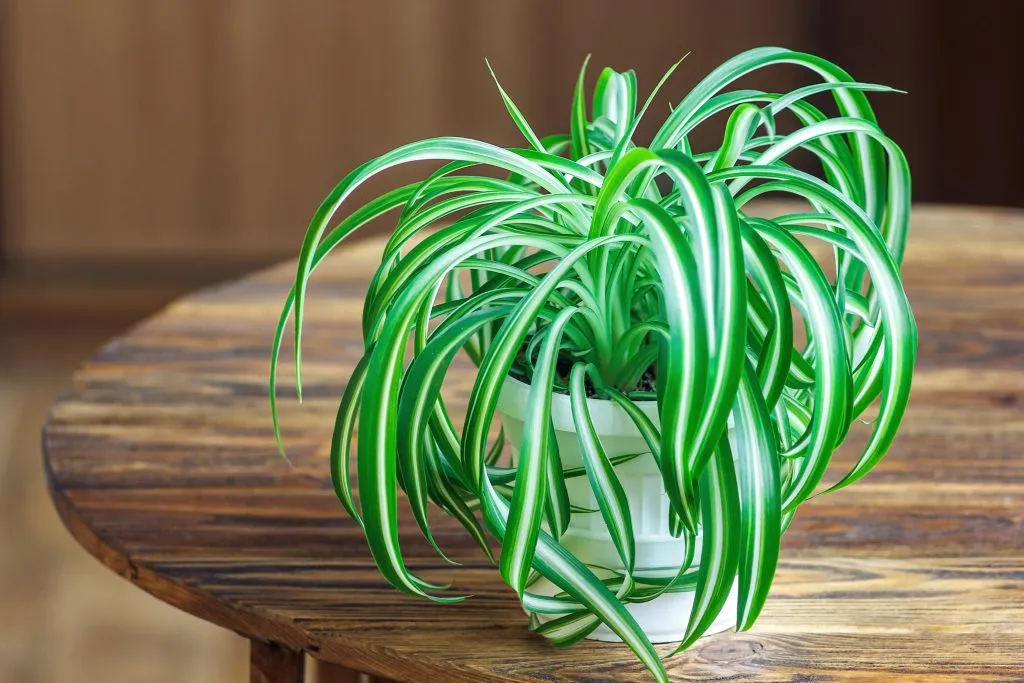
Scientifically known as Chlorophytum comosum, the spider plant is native to Africa’s tropical areas.
The spider plant is a popular houseplant that grows at a moderate rate. It produces long narrow leaves and greenish-white inflorescences.
Plant enthusiasts appreciate spider plants because they do not need a perfect replication of their natural habitat.
Moreover, they can be taught to grow in various forms – upright, as hanging plants, and even as edging or ground cover plants.
Things to Consider While Choosing a Plant for Your Corn Snake
Naturally, not all plants are suitable for your corn snake’s habitat, which is why you shouldn’t rush to purchase one.
It would be a pity to care for a plant that was meant to die in a humid habitat even before being planted. However, humidity levels aren’t the only factors you should consider while choosing a species.
Keep reading to learn what else matters!
The Plant’s Thriving Conditions
Naturally, you’ll want to choose a plant that can thrive in the same habitat as your corn snake.
As an introduction, we prepared a comprehensive summary of light, temperature, and humidity levels required in a corn snake’s vivarium:
| Light | Temperature | Humidity |
| 12 hours of light a day UVB light providing 2.0-3.0 UVI | Ambient temperature: 78-82°F (25-27°C) Cool side: 75°F (23-24°C) Basking area: 90°F (32°C) Night temperature: not lower than 65°F (18.3°C) | 65-75% humidity levels |
Watch this comprehensive corn snake care guide if you want to learn more!
Humidity
One of the most important things to consider is the humidity – some plants come from humid places, others from dry areas. As such, they certainly won’t survive in habitats that do not provide the required humidity/dryness.
For example, if a plant requires 40-50% humidity, it might survive in your snake’s habitat, but you may want to place it far away from the mister (if you have one).
Temperature
Before deciding on a plant, you’ll have to do some research and understand what temperatures it needs both in daylight and at night.
This will help you decide on which side of the
For example, a corn snake can tolerate cooler temperatures at night. Some plants, however, should be kept at a minimum of 70°F.
Light
There’s another thing to consider – does the plant thrive in full shade, part-shade, or full sun?
Corn snakes are crepuscular creatures, so they won’t tolerate the extremely brightly-lit habitats required for plants that grow in full sun only.
You’ll want to go with plants labeled as either “full shade” and “low light” or “part shade/part sun” and “indirect sunlight.” Check out this article to read more about a plant’s light requirements.
Tip: Also read our article on whether you should install a heat lamp or a heat mat in your snake tank!
Plant Requirements
Here’s a table with the details you need for the plants listed in this article:
| Plant | Origin | Temperature | Humidity | Light exposure |
| Bromeliads | Tropical Americas | 60-85°F | 60%+ | Indirect sunlight |
| Peacock plant | Espirito Santo, Brazil | 60-75°F | 60%+ | Part sun, full shade |
| Emerald ripple peperomia | Brazil | 65-80°F | 40-50% | Indirect sunlight |
| Corn plant | Mozambique | 60-75°F | 40-50% | Indirect sunlight |
| Golden pothos | Mo’orea, Society Islands | 70-90°F | 50-70% | Indirect sunlight |
| Common staghorn fern | New Guinea, Australia | 60-80°F | 70-80% | Indirect sunlight |
| Boston fern | The Americas | 60-75°F | 60-70%+ | Indirect sunlight |
| Bird’s nest fern | Asia, Australia, Africa, Polynesia | 70-90°F | 50%+ | Indirect sunlight |
| Maidenhair fern | North America | 60-80°F | 60%+ | Indirect sunlight |
| Heartleaf philodendron | Central America, the Caribbean | 65-85°F | 40%+ | Low light |
| Inch plant | Mexico, Colombia, Central America | 65-75°F | 60%+ | Indirect sunlight |
| Jewel orchid | Asia | 60-89°F | 50-70% | Indirect sunlight |
| Spider plant | Africa | 65-85°F | 60% | Indirect sunlight |
Planting Method
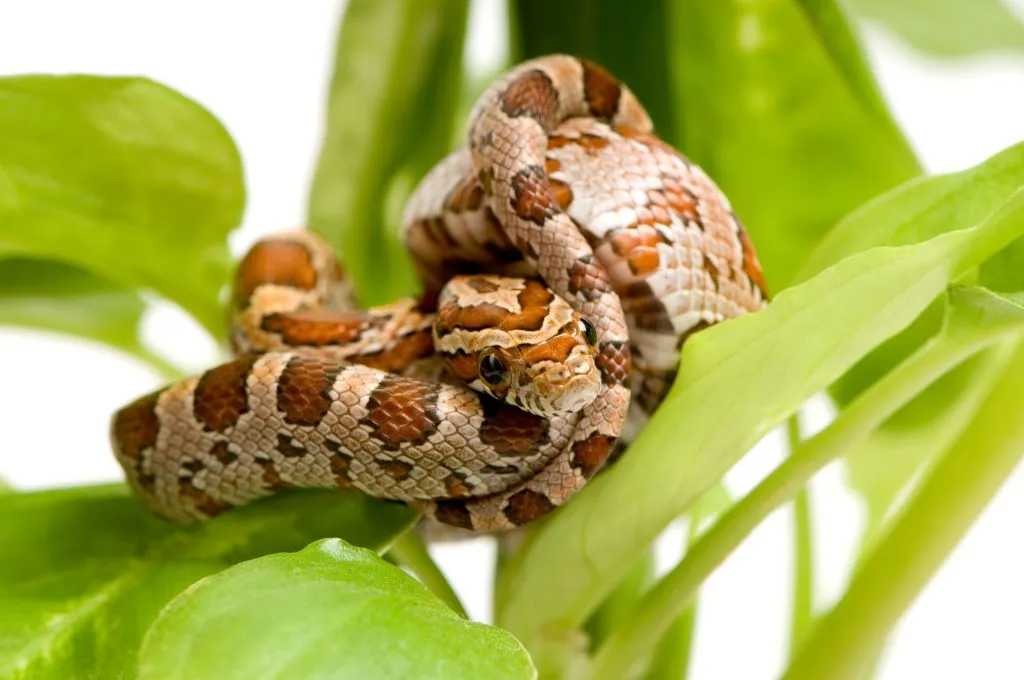
Another thing to ponder before buying a plant is the planting method.
Do you want to plant it directly into the substrate, or do you prefer to keep it in a small pot? Some prefer leaving the plant in a pot and taking it off once in a while to clean or prune it.
Moreover, you’ll also want to place the plants in a way that’s easy for you to reach them, and your snake doesn’t damage them in no time.
On the other hand, if you want to plant it directly in the bedding, you need to ensure that the substrate in your corn snake’s vivarium can sustain your plant’s life, too.
Alternatively, you can change the
Plant Light
It’s highly likely that your plant won’t be able to thrive only under your reptile’s UVB light.
That’s because plants need actual light, which fuels photosynthesis. Otherwise, the plant will struggle to grow, will burn, and eventually die.
Some plants do well with indirect sunlight, so most of them will thrive in a terrarium where they get not a lot of “real light”.
However, other plants need more light, and since plants can photosynthesize through glass, it is recommended to use a plant light like this next to the corn snake
Toxicity
While corn snakes are carnivorous and they won’t eat the plants, some may emit odors that can harm your reptile.
Moreover, many of the plants that are safe for your corn snake can be harmful to your other pets or even yourself and your children. Check out this website for lists of toxic and non-toxic plants for cats and dogs.
Naturally, your dog or cat shouldn’t be able to get into your reptile’s
So if you do decide on a plant that can be toxic for pets, ensure that they cannot reach it.
Timeframe
It’s generally recommended to buy plants around two weeks before planting them.
The plant may sometimes contain chemicals that can harm your pet.
Once you buy it, you’ll have to remove it from the pot, wash the leaves, rinse the extra soil from the root ball, and repot the plant with organic topsoil.
Then, you’ll have to let it sit for around two weeks so that any remaining chemicals disappear.
Growing Habits
Some plants are excessive growers. Heartleaf philodendrons, for example, can reach 13 feet wide if not pruned. So you should choose a plant that doesn’t grow too tall and wide or prepare yourself for regular pruning.
Pruning plants isn’t too difficult though. You never know – this might even become your new favorite hobby!
Watch this video to learn more about pruning plants!
- Enchi Ball Python: A Unique and Stunning Morph of Python regius - March 27, 2025
- Emerald Tree Monitor: The Enigmatic Green Guardian of the Rainforest - March 26, 2025
- The Egyptian Cobra (Naja haje): A Fascinating Serpent - March 25, 2025
